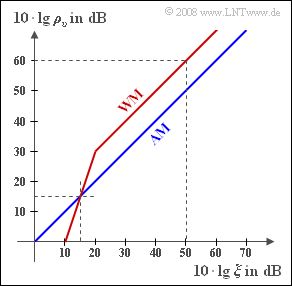Exercise 3.10Z: Amplitude and Angle Modulation in Comparison
Betrachtet wird die Übertragung eines Cosinussignals mit Amplitudenmodulation und Winkelmodulation. Es gelten folgende Randbedingungen:
- Nachrichtenfrequenz $f_N = 10 kHz$,
- Sendeleistung $P_S = 100 kW$,
- Kanaldämpfungsfaktor $20 · lg α_K = –120 dB$,
- Rauschleistungsdichte $N_0 = 10^{–16} W/Hz$.
Diese Systemparameter werden zweckmäßigerweise zur gemeinsamen Leistungskenngröße $$ \xi = \frac{\alpha_{\rm K}^2 \cdot P_{\rm S}}{N_0 \cdot B_{\rm NF}}$$ zusammengefasst. Die Grafik zeigt den sich ergebenden Sinken–Störabstand $10 · lg ρ_υ$ in Abhängigkeit der logarithmierten Leistungskenngröße $ξ$.
Hinweis: Die Aufgabe bezieht sich auf die theoretischen Grundlagen von Kapitel 2.2 , Kapitel 3.2 und Kapitel 3.3. Es gelten folgende Beziehungen: $$\rho_{v } = \left\{ \begin{array}{c} \xi \\ {\eta^2}/2 \cdot\xi \\ 3{\eta^2}/2 \cdot\xi \\ \end{array} \right.\quad \begin{array}{*{10}c} {\rm{bei}} \\ {\rm{bei}} \\ {\rm{bei}} \\ \end{array}\begin{array}{*{20}l} {\rm ZSB/ESB-AM \hspace{0.15cm}ohne \hspace{0.15cm}Tr\ddot{a}ger} \hspace{0.05cm}, \\ {\rm PM \hspace{0.15cm}mit \hspace{0.15cm}Modulationsgrad \hspace{0.15cm} \eta } \hspace{0.05cm}, \\ {\rm FM \hspace{0.15cm}mit \hspace{0.15cm}Modulationsgrad \hspace{0.15cm} \eta }\hspace{0.05cm}. \\ \end{array}$$ Die Bandbreiten bei Winkelmodulation sind so zu wählen, dass ein Klirrfaktor K kleiner als 1% garantiert werden kann (Carson–Regel): $$ B_{\rm K} = 2 \cdot f_{\rm N} \cdot (\eta +2) \hspace{0.05cm}.$$
Fragebogen
Musterlösung
